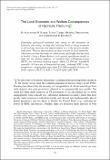The Local Economic and Welfare Consequences of Hydraulic Fracturing
Author(s)
Bartik, Alexander W; Currie, Janet; Greenstone, Michael; Knittel, Christopher R
DownloadPublished version (9.587Mb)
Publisher Policy
Publisher Policy
Article is made available in accordance with the publisher's policy and may be subject to US copyright law. Please refer to the publisher's site for terms of use.
Terms of use
Metadata
Show full item recordAbstract
© 2019 American Economic Association. Exploiting geological variation and timing in the initiation of hydraulic fracturing, we find that fracking leads to sharp increases in oil and gas recovery and improvements in a wide set of economic indicators. There is also evidence of deterioration in local amenities, which may include increases in crime, noise, and traffic and declines in health. Using a Rosen-Roback-style spatial equilibrium model to infer the net welfare impacts, we estimate that willingness-to-pay (WTP) for allowing fracking equals about $2,500 per household annually (4.9 percent of household income), although WTP is heterogeneous, ranging from more than $10,000 to roughly 0 across 10 shale regions.
Date issued
2019Department
Sloan School of ManagementJournal
AEJ: Applied Economics
Publisher
American Economic Association